Optimization of Branch Airflow Volume for Mine Ventilation Network Based on Sensitivity Matrix
Abstract
:1. Introduction
2. Case Analysis and Optimization Process Construction
2.1. Case Mine Ventilation System Overview
2.2. Optimization Analysis Process Construction
- (1)
- The ventilation network diagram of the −600 m level is drawn according to the main branches, nodes, airflow direction, and branch ventilation resistance in the ventilation roadway diagram of the −600 m level. Additionally, the sensitivity matrix D and influence matrix U of branches are calculated.
- (2)
- The airflow volume in the −600 m level to be adjusted to branch i is determined. According to the airflow volume adjustment demand of branch i, the resistance increase adjustment and resistance reduction adjustment are analyzed in turn. The branch sensitivity analysis of element dij in the i-th row of matrix D is carried out, and the corresponding branch j is arranged in descending order to obtain set E1. Branch j is arranged in ascending order according to the influence value Uj to obtain set E2. The front branches of sets E1 and E2 are selected as the preferred adjustment branches.
- (3)
- The ventilation resistance adjustment method is determined by analyzing the adjustment effect and engineering benefit, and the adjustment scheme of the roadway is formulated. The scheme is simulated to test the adjustment effect of the scheme with Ventsim.
3. Sensitivity Matrix Analysis and Scheme Formulation
3.1. Ventilation Network Sensitivity Matrix Calculation
- (1)
- Fuzzy simplification
- (2)
- Equivalent simplification
3.2. Sensitivity Matrix Analysis
- (1)
- Adjust the airflow volume by increasing the ventilation resistance
- ①
- Branch sensitivity analysis: The resistance-increasing branch is selected according to the branch sensitivity matrix. The ninth-row data in the sensitivity matrix D are selected for analysis because of the objective of increasing the airflow volume of branch P09. d9j = [0, 11.7987, −94.3895, 0, 82.5908, −23.5974, −141.5842, −1156.2713, −802.3107, −47.1947, 66.0726, 283.1685, 1533.8292, −217.0985, −10.4877, 0]. The elements greater than 0 in d9j and the corresponding branches are selected and arranged in descending order according to the sensitivity weight, that is, P13, P12, P05, P11, and P02.
- ②
- Branch influence value analysis: The influence value of the above branches is selected according to the branch influence value matrix U. Ua = [188.75, 9698.52, 1321.45, 3374.42, 7574.76]. Five branches are arranged in ascending order of influence value, that is, P2, P11, P12, P13, and P5.
- (2)
- Adjust the airflow volume by decreasing the ventilation resistance
- ①
- Branch sensitivity analysis: The resistance-decreasing branch is selected according to the branch sensitivity matrix. The ninth-row data in the sensitivity matrix D are selected for analysis because of the objective of increasing the airflow volume of branch P09. d9j = [0, 11.7987, −94.3895, 0, 82.5908, −23.5974, −141.5842, −1156.2713, −802.3107, −47.1947, 66.0726, 283.1685, 1533.8292, −217.0985, −10.4877, 0]. The elements less than 0 in d9j and the corresponding branches are selected and arranged in descending order according to the sensitivity weight, that is, P08, P09, P14, P07, P03, P10, P06, and P15.
- ②
- Branch influence value analysis: The influence value of the above branches is selected according to the branch influence value matrix U. Ub = [3586.80, 5191.42, 4105.42, 11,739.69, 2878.88, 424.75, 1802.84, 372.31]. Eight branches are arranged in ascending order of influence value, that is, P15, P10, P14, P09, P03, P07, P06, and P08.
3.3. Regulation Scheme Formulation
- (1)
- Determine the adjustment branch and ventilation resistance mode
- ①
- Simulation data analysis: Branch P12’s ventilation resistance is increased by 40%, and branch P14’s ventilation resistance is reduced by 40% based on the initial ventilation resistance. The simulated airflow volume data of the branches before and after adjustment are shown in Table 3.
- ②
- Engineering economic benefit analysis: It is necessary to further analyze the adjustment scheme in terms of economic rationality and technical feasibility in the process of mine engineering practice. The resistance increase adjustment is usually set in the production stope or chamber to reduce the impact of the adjustment measures on the transportation operation and to consider the economy of the project implementation. The resistance reduction adjustment is usually set in the intake and return air areas to achieve better economic benefits for the relatively long service life of the intake and return air shafts.
- (2)
- Roadway ventilation resistance adjustment scheme
4. Analysis of Scheme Adjustment Effect
4.1. Branch Airflow Volume Adjustment and Influence
4.2. Analysis of Airflow Volume Regulation Effect in the Ventilation System
5. Discussion
6. Conclusions
Author Contributions
Funding
Institutional Review Board Statement
Informed Consent Statement
Data Availability Statement
Conflicts of Interest
References
- Nel, A.J.H.; Vosloo, J.C.; Mathews, M.J. Evaluating complex mine ventilation operational changes through simulations. J. Energy South. Afr. 2018, 29, 22–32. [Google Scholar] [CrossRef]
- Acuña, E.I.; Lowndes, I.S. A Review of Primary Mine Ventilation System Optimization. Interfaces 2014, 44, 163–175. [Google Scholar] [CrossRef]
- Kurnia, J.C.; Sasmito, A.P.; Mujumdar, A.S. CFD simulation of methane dispersion and innovative methane management in underground mining faces. Appl. Math. Model. 2014, 38, 3467–3484. [Google Scholar] [CrossRef]
- Roghanchi, P.; Kocsis, K.C. Challenges in Selecting an Appropriate Heat Stress Index to Protect Workers in Hot and Humid Underground Mines. Saf. Health Work 2018, 9, 10–16. [Google Scholar] [CrossRef]
- Brodny, J.; Tutak, M. Determination of the Zone Endangered by Methane Explosion in Goaf with Caving of Longwalls Ventilated on Y System. Manag. Syst. Prod. Eng. 2016, 24, 247–251. [Google Scholar] [CrossRef]
- Wallace, K.; Prosser, B.; Stinnette, J.D. The practice of mine ventilation engineering. Int. J. Min. Sci. Technol. 2015, 25, 165–169. [Google Scholar] [CrossRef]
- Yi, H.; Kim, M.; Lee, D.; Park, J. Applications of Computational Fluid Dynamics for Mine Ventilation in Mineral Development. Energies 2022, 15, 8405. [Google Scholar] [CrossRef]
- Sjöström, S.; Klintenäs, E.; Johansson, P.; Nyqvist, J. Optimized model-based control of main mine ventilation air flows with minimized energy consumption. Int. J. Min. Sci. Technol. 2020, 30, 533–539. [Google Scholar] [CrossRef]
- Ajayi, K.M.; Shahbazi, K.; Tukkaraja, P.; Katzenstein, K. Prediction of airway resistance in panel cave mines using a discrete and continuum model. Int. J. Min. Sci. Technol. 2019, 29, 781–784. [Google Scholar] [CrossRef]
- Prince; Hati, A.S.; Chakrabarti, P.; Abawajy, J.H.; Keong, N.W. Development of energy efficient drive for ventilation system using recurrent neural network. Neural Comput. Appl. 2021, 33, 8659–8668. [Google Scholar] [CrossRef]
- Nyaaba, W.; Frimpong, S.; El-Nagdy, K.A. Optimisation of mine ventilation networks using the Lagrangian algorithm for equality constraints. Int. J. Min. Reclam. Environ. 2014, 29, 201–212. [Google Scholar] [CrossRef]
- Xu, G.; Huang, J.; Nie, B.; Chalmers, D.; Yang, Z. Calibration of Mine Ventilation Network Models Using the Non-Linear Optimization Algorithm. Energies 2017, 11, 31. [Google Scholar] [CrossRef]
- Yu, B.-C.; Shao, L.-S. A Mine Ventilation System Energy Saving Technique Based on an Improved Equilibrium Optimizer. Front. Energy Res. 2022, 10, 913817. [Google Scholar] [CrossRef]
- Li, B.-R.; Inoue, M.; Shen, S.-B. Mine Ventilation Network Optimization Based on Airflow Asymptotic Calculation Method. J. Min. Sci. 2018, 54, 99–110. [Google Scholar] [CrossRef]
- Prince; Hati, A.S.; Kumar, P. An adaptive neural fuzzy interface structure optimisation for prediction of energy consumption and airflow of a ventilation system. Appl. Energy 2023, 337, 913817. [Google Scholar]
- Wang, S.; Wang, W.-P.; Shao, K.; Ding, W.-H.; Cui, Z.; Shao, W.; Ji, W.-X. Operation optimization of a refrigeration ventilation system for the deep metal mine. Case Stud. Therm. Eng. 2023, 44, 102817. [Google Scholar] [CrossRef]
- Chatterjee, A.; Zhang, L.; Xia, X. Optimization of mine ventilation fan speeds according to ventilation on demand and time of use tariff. Appl. Energy 2015, 146, 65–73. [Google Scholar] [CrossRef]
- Natalie, G. 3D Simulation Software Package for Mine Ventilation. Creamer Media’s Min. Wkly. 2011, 17, 1–27. [Google Scholar]
- Șuvar, M.C.; Cioclea, D.; Arad, V.; Lupu, C.; Vlasin, N.I. Method for Improving the Management of Mine Ventilation Networks After an Explosion. Environ. Eng. Manag. J. 2017, 16, 1373–1381. [Google Scholar] [CrossRef]
- Park, J.; Jo, Y.; Park, G. Flow characteristics of fresh air discharged from a ventilation duct for mine ventilation. J. Mech. Sci. Technol. 2018, 32, 1187–1194. [Google Scholar] [CrossRef]
- Morar, M.S.; Radu, S.M.; Lupu, C.; Cioclea, D.; Gherghe, I. Optimization of Underground Environment by Improving the Management of Ventilation Networks. Environ. Eng. Manag. J. 2017, 16, 1409–1414. [Google Scholar] [CrossRef]
- Zhou, L.; Thomas, R.A.; Yuan, L.; Bahrami, D. Experimental Study of Improving a Mine Ventilation Network Model Using Continuously Monitored Airflow. Min. Metall. Explor. 2022, 39, 887–895. [Google Scholar] [CrossRef]
- Semin, M.A.; Levin, L.Y. Stability of air flows in mine ventilation networks. Process Saf. Environ. Prot. 2019, 124, 167–171. [Google Scholar] [CrossRef]
- Develo, E.; Pillalamarry, M.; Garab, E. Improving the ventilation system at Rosh Pinah zinc mine. J. South. Afr. Inst. Min. Metall. 2016, 116, 301–305. [Google Scholar] [CrossRef]
- Grzegorz, P. Optimization of Forced Air Flow by the Comparison of Positive and Negative Regulations in Mine Ventilation Network. Arch. Min. Sci. 2018, 63, 853–870. [Google Scholar]
- Wang, J.; Jia, M.; Bin, L.; Wang, L.; Zhong, D. Regulation and optimization of air quantity in a mine ventilation network with multiple fans. Arch. Min. Sci. 2022, 67, 179–193. [Google Scholar]
- Jia, P.; Jia, J.; Song, L.; Li, Z.; Li, B. Theory of RPOD adjustment of air volume for mine intelligent ventilation. Int. J. Vent. 2021, 21, 316–329. [Google Scholar] [CrossRef]
- Hao, H.; Jiang, S.; Wang, K.; Zhang, Y.; Wu, Z. Multi-branch joint adjustment method of mine ventilation based on sensitivity. Int. J. Vent. 2022, 22, 207–224. [Google Scholar] [CrossRef]
- Dziurzyński, W.; Krach, A.; Pałka, T. Airflow Sensitivity Assessment Based on Underground Mine Ventilation Systems Modeling. Energies 2017, 10, 1451. [Google Scholar] [CrossRef]
- Jia, J.; Li, B.; Ke, D.; Wu, Y.; Zhao, D.; Wang, M. Optimization of mine ventilation network feature graph. PLoS ONE 2020, 15, e0242011. [Google Scholar] [CrossRef]
- Bascompta, M.; Sanmiquel, L.; Zhang, H. Airflow Stability and Diagonal Mine Ventilation System Optimization: A Case Study. J. Min. Sci. 2019, 54, 813–820. [Google Scholar] [CrossRef]
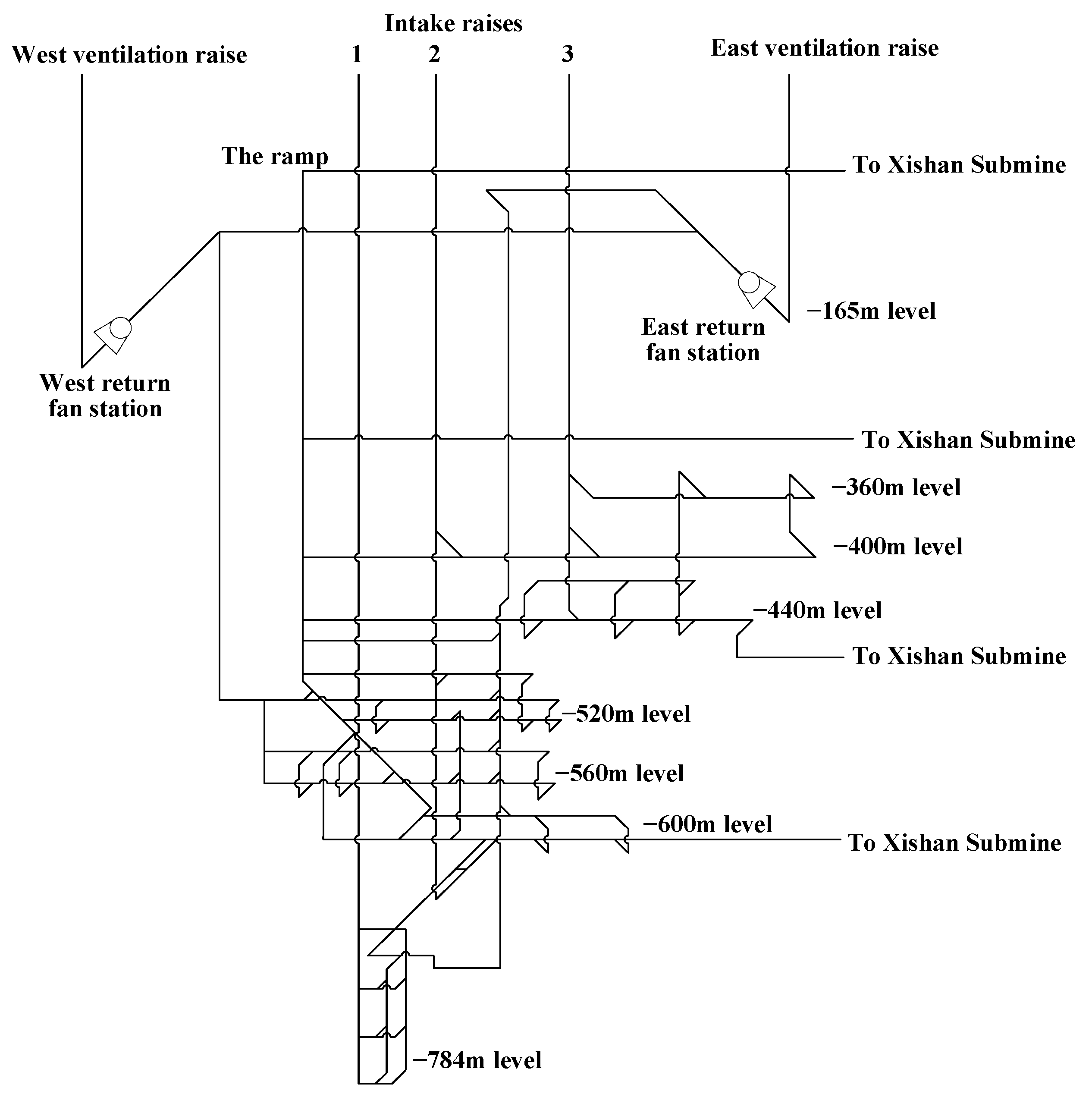
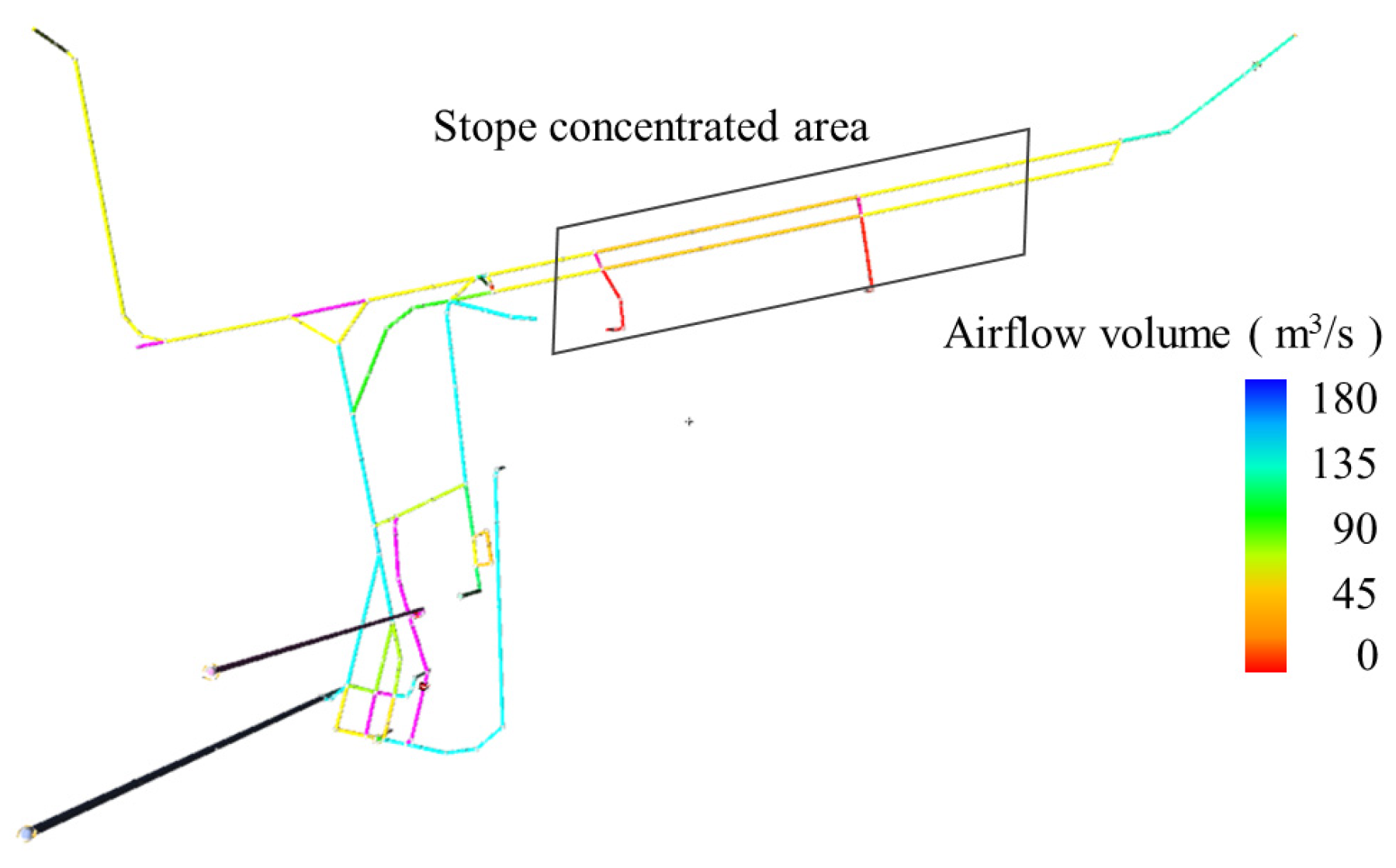
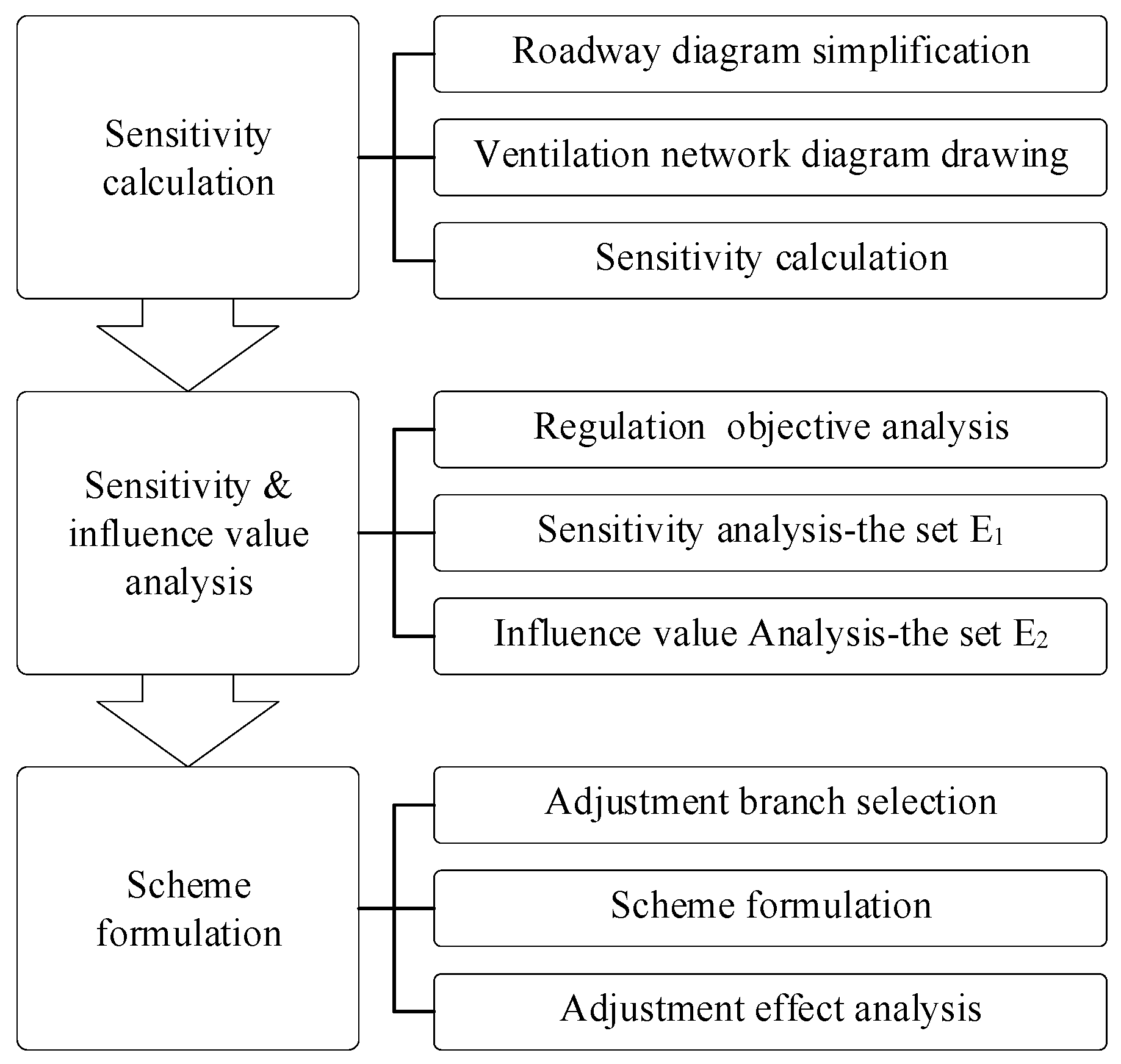
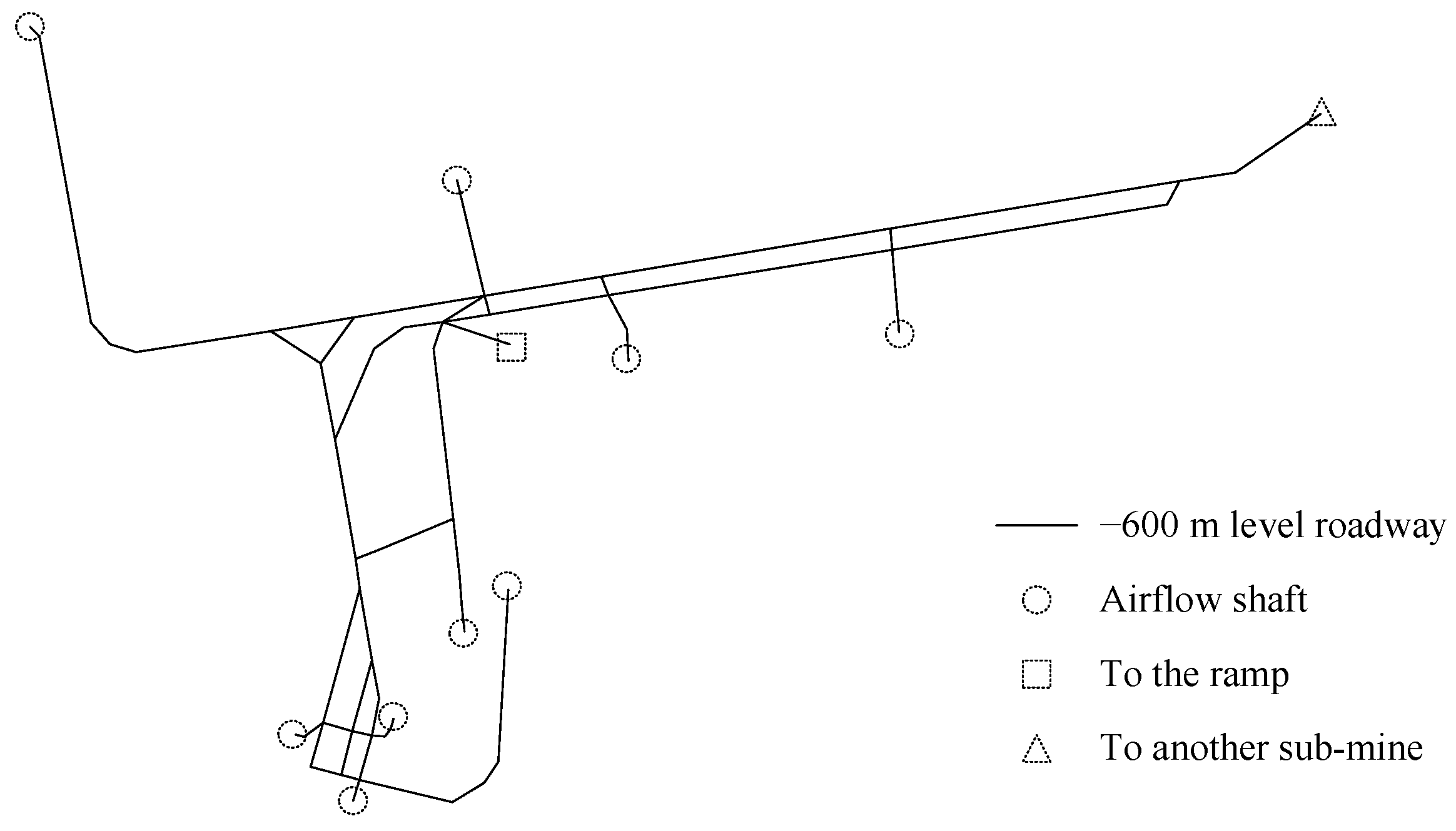
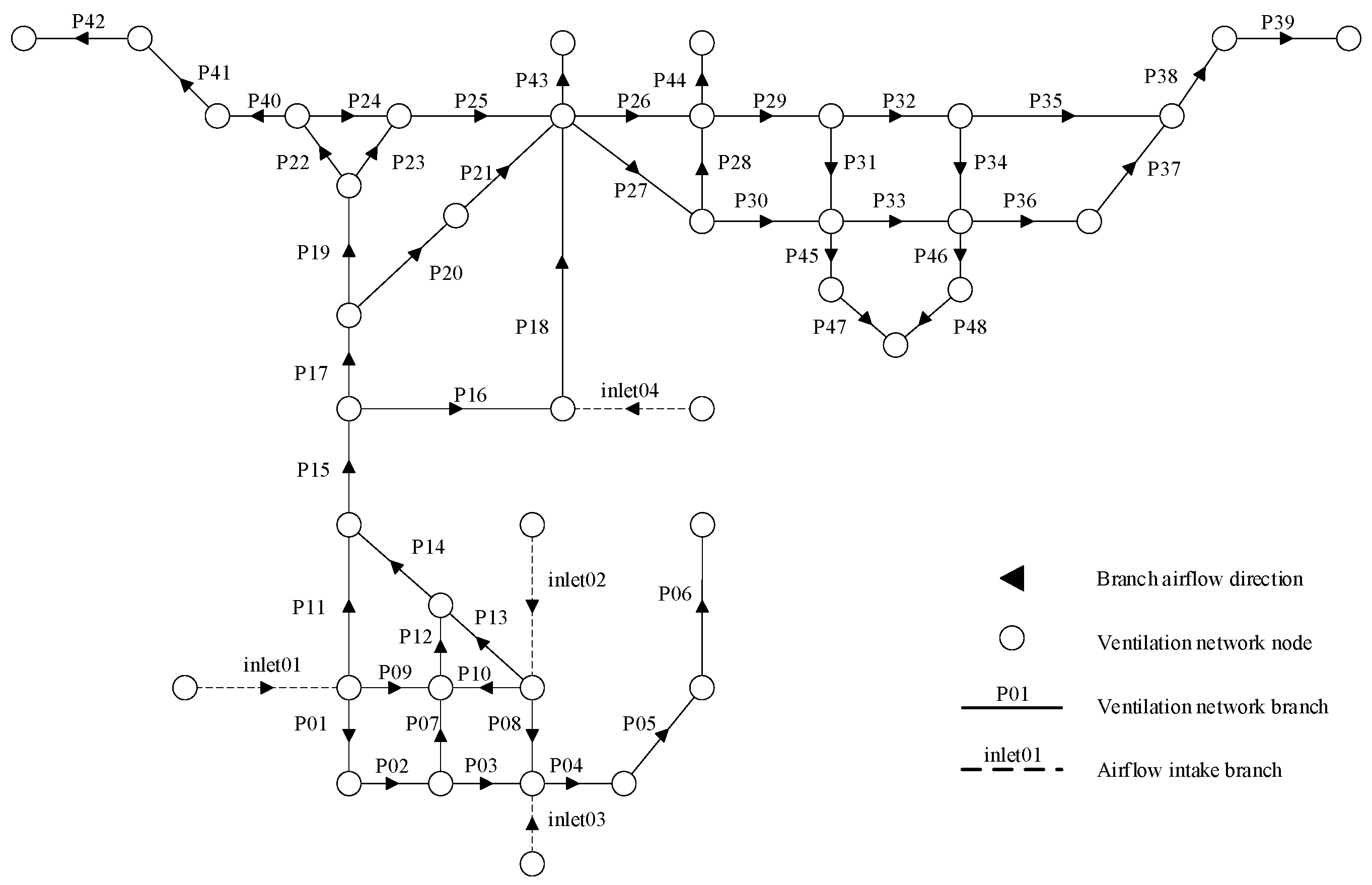

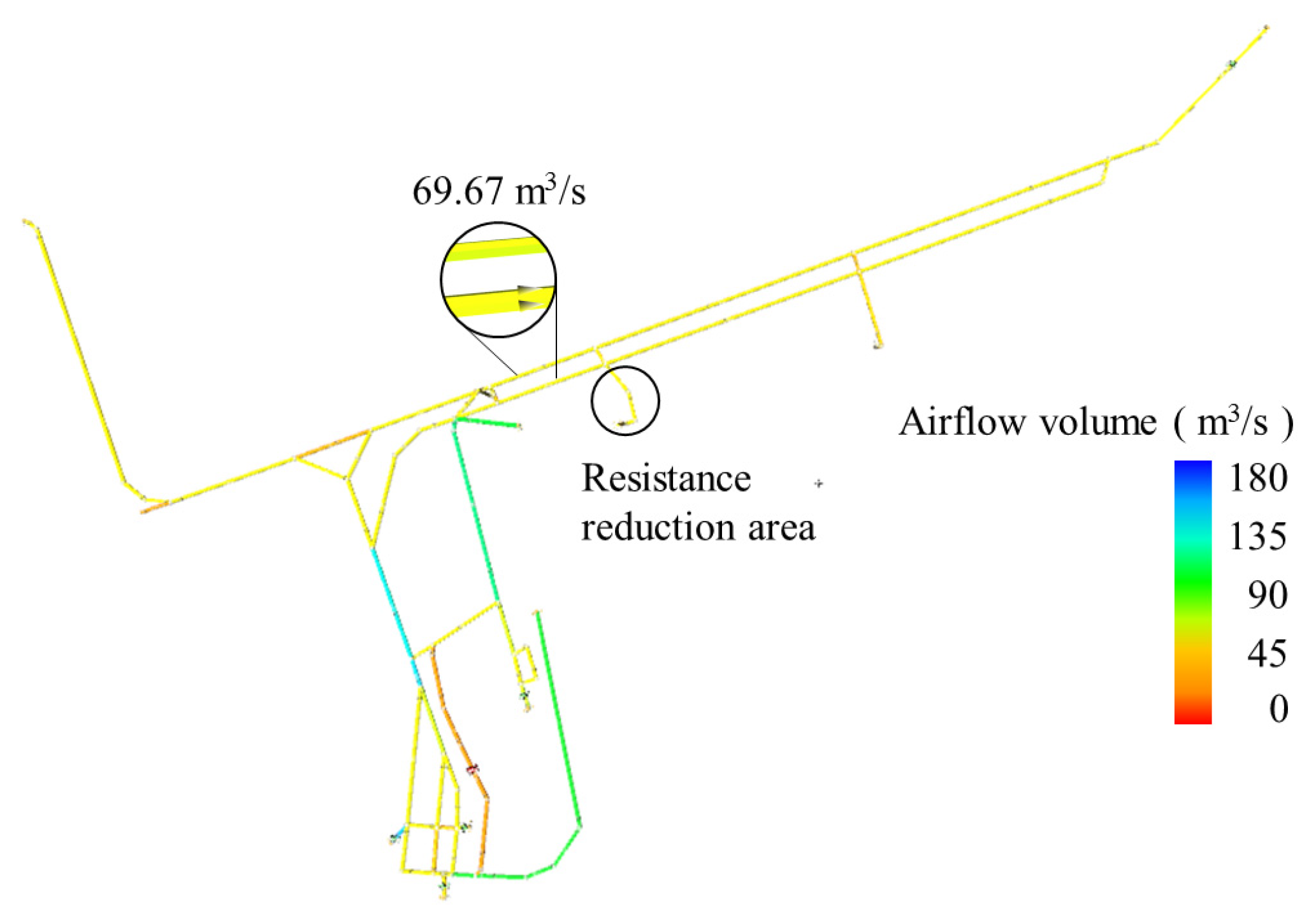
| Level/m | Airflow Volume/m3·s−1 | Percentage/% | |||
|---|---|---|---|---|---|
| Intake Air Shaft 1 | Intake Air Shaft 2 | Intake Air Shaft 3 | Subtotal | ||
| −400 | — | — | 22.90 | 22.90 | 6.0 |
| −440 | — | 28.00 | 45.19 | 73.19 | 19.1 |
| −480 | — | 14.56 | — | 14.56 | 3.8 |
| −600 | 136.01 | 66.08 | — | 202.09 | 52.7 |
| −675 | 60.28 | — | — | 60.28 | 15.7 |
| −720 | 4.85 | — | — | 4.85 | 1.3 |
| −784 | 5.28 | — | — | 5.28 | 1.4 |
| Subtotal | 206.42 | 108.64 | 68.09 | 383.15 | 100 |
| Branch | Airflow Volume/m3·s−1 | Ventilation Resistance/N·s2·m−8 | Branch | Airflow Volume/m3·s−1 | Ventilation Resistance/N·s2·m−8 |
|---|---|---|---|---|---|
| inlet01 | 136.00 | — | P07 | 138.46 | 0.01236 |
| inlet02 | 55.00 | — | P08 | 185.39 | 0.00420 |
| inlet03 | 15.40 | — | P09 | 67.02 | 0.00997 |
| inlet04 | 66.10 | — | P10 | 55.01 | 0.02469 |
| P01 | 14.93 | 0.00402 | P11 | 29.54 | 0.04763 |
| P02 | 30.03 | 0.41221 | P12 | 24.37 | 0.01500 |
| P03 | 175.03 | 0.01525 | P13 | 117.38 | 0.00193 |
| P04 | 6.51 | 0.00896 | P14 | 12.00 | 0.00503 |
| P05 | 168.48 | 0.00434 | P15 | 13.11 | 0.00897 |
| P06 | 72.20 | 0.01714 | P16 | 41.82 | 0.04435 |
| Branch | Airflow Volume Requirement /m3·s−1 | Before/m3·s−1 | After/m3·s−1 | |
|---|---|---|---|---|
| P12 (Increasing Ventilation Resistance) | P14 (Decreasing Ventilation Resistance) | |||
| P01 | 9 | 14.93 | 14.93 | 14.93 |
| P02 | 25 | 30.03 | 30.03 | 30.03 |
| P03 | 86 | 175.03 | 174.88 | 175.05 |
| P04 | 5 | 6.51 | 6.20 | 6.53 |
| P05 | 89 | 168.48 | 168.79 | 168.45 |
| P06 | 70 | 72.20 | 72.50 | 72.20 |
| P07 | 76 | 138.46 | 137.64 | 138.49 |
| P08 | 126 | 185.39 | 188.74 | 185.69 |
| P09 | 13 | 67.02 | 68.76 | 68.64 |
| P10 | 13 | 55.01 | 55.82 | 53.08 |
| P11 | 13 | 29.54 | 30.32 | 29.52 |
| P12 | 20 | 24.37 | 19.61 | 24.21 |
| P13 | 60 | 117.38 | 119.19 | 116.36 |
| P14 | 10 | 12.00 | 13.21 | 14.78 |
| P15 | 10 | 13.11 | 13.39 | 11.85 |
| P16 | 40 | 41.82 | 41.91 | 41.20 |
| Branch | Airflow Volume Requirement/m3·s−1 | Airflow Volume/m3·s−1 | Difference/m3·s−1 | |
|---|---|---|---|---|
| Before | After | |||
| P01 | 9 | 14.93 | 14.93 | 0 |
| P02 | 25 | 30.03 | 30.03 | 0 |
| P03 | 86 | 175.03 | 175.05 | 0.02 |
| P04 | 5 | 6.51 | 6.53 | 0.02 |
| P05 | 89 | 168.48 | 168.45 | −0.03 |
| P06 | 70 | 72.20 | 72.20 | 0 |
| P07 | 76 | 138.46 | 138.49 | 0.03 |
| P08 | 126 | 185.39 | 185.69 | 0.30 |
| P09 | 13 | 67.02 | 68.64 | 1.62 |
| P10 | 13 | 55.01 | 53.08 | −1.93 |
| P11 | 13 | 29.54 | 29.52 | −0.02 |
| P12 | 20 | 24.37 | 24.21 | −0.16 |
| P13 | 60 | 117.38 | 116.36 | −1.02 |
| P14 | 10 | 12.00 | 14.78 | 2.78 |
| P15 | 10 | 13.11 | 11.85 | −1.26 |
| P16 | 40 | 41.82 | 41.20 | −0.62 |
Disclaimer/Publisher’s Note: The statements, opinions and data contained in all publications are solely those of the individual author(s) and contributor(s) and not of MDPI and/or the editor(s). MDPI and/or the editor(s) disclaim responsibility for any injury to people or property resulting from any ideas, methods, instructions or products referred to in the content. |
© 2023 by the authors. Licensee MDPI, Basel, Switzerland. This article is an open access article distributed under the terms and conditions of the Creative Commons Attribution (CC BY) license (https://creativecommons.org/licenses/by/4.0/).
Share and Cite
Hou, J.; Nie, G.; Li, G.; Zhao, W.; Sheng, B. Optimization of Branch Airflow Volume for Mine Ventilation Network Based on Sensitivity Matrix. Sustainability 2023, 15, 12427. https://doi.org/10.3390/su151612427
Hou J, Nie G, Li G, Zhao W, Sheng B. Optimization of Branch Airflow Volume for Mine Ventilation Network Based on Sensitivity Matrix. Sustainability. 2023; 15(16):12427. https://doi.org/10.3390/su151612427
Chicago/Turabian StyleHou, Jie, Gang Nie, Guoqing Li, Wei Zhao, and Baoli Sheng. 2023. "Optimization of Branch Airflow Volume for Mine Ventilation Network Based on Sensitivity Matrix" Sustainability 15, no. 16: 12427. https://doi.org/10.3390/su151612427
APA StyleHou, J., Nie, G., Li, G., Zhao, W., & Sheng, B. (2023). Optimization of Branch Airflow Volume for Mine Ventilation Network Based on Sensitivity Matrix. Sustainability, 15(16), 12427. https://doi.org/10.3390/su151612427








